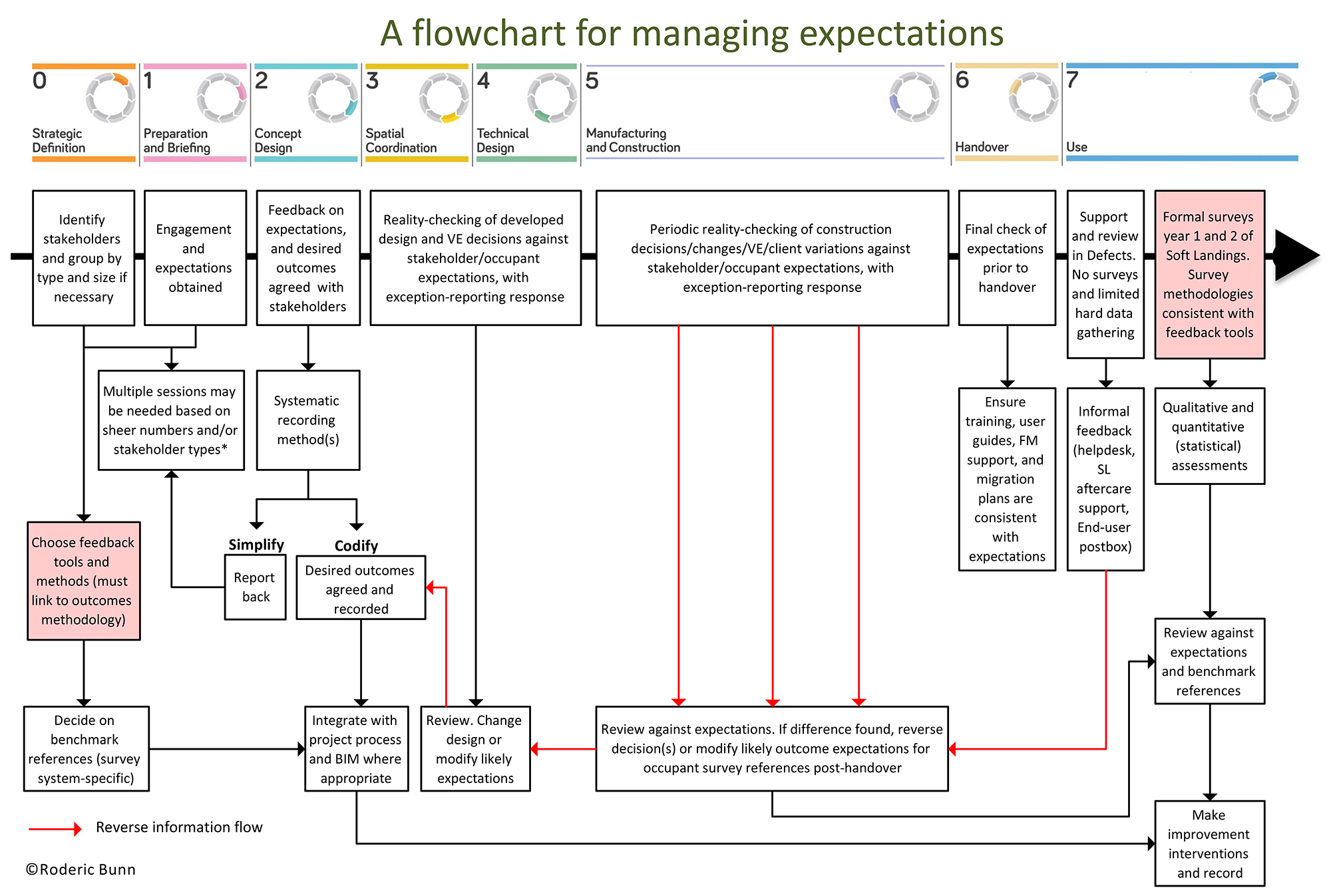Expectation management in building design
Contents |
[edit] Expectation management
Expectation management describes a defined approach where specific consideration is given to the anticipated delivery of an item by one party to another. The item being delivered may be almost anything from products to services or roles, with the parties being clients, customers, employers, or employees (for employees, see also Expectancy Theory, V. Vroom, 1964). It is a management approach that relates to conception, briefing, communication, and feedback strategies, which in turn can influence programme progression and ultimately the actual or perceived success of a project, scheme, or building.
[edit] Expectation interest
Expectation interest, more formally, is a legal term sometimes used in construction as one of the two categories of potential damages, the other being reliance expenditure. In quite abstract but legal terms, it might be described as the value to a promisee of a promise, which in practical terms might be the difference between the market value of a property without defects (i.e. where a construction promise or contract has been upheld) and the market value of the property with the defects (where the promise or contract has not).
While the term as used in expectation management is not necessarily directly linked, it may be more relevant if energy performance in use is part of the contractual obligations, which may, for example, be the case in energy performance contracting. In this case, it would need to be argued that the poor energy performance of a building would, under the contract, qualify as a defect, and as such, the definition of poor would most likely need to have been quantified, stated, and agreed upon at the start of the contract.
[edit] Performance gap
It is not clear when the phrase started to be used, particularly in relation to project management, buildings, and construction. However, the growing realisation that end-user expectations needed to be obtained and managed grew out of post-occupancy studies of non-domestic buildings, notably the Post-occupancy Review of Buildings and their Engineering (PROBE) studies carried out between 1995 and 2002 and subsequent building performance evaluation research programmes using the PROBE techniques. In this context, expectation management is most commonly associated with outturn energy performance and levels of occupant satisfaction. Expectations of performance expected by a user, client, or design team need to be assessed and compared with actual measured outcomes, and any disparities investigated and resolved.
Published post-occupancy studies carried out by the PROBE Team, the Carbon Trust (2006–2011), and more recently by InnovateUK (2011–2015) often revealed large differences between what was expected in terms of energy performance and occupant satisfaction and what was delivered. This became popularised as the performance gap. In this context, expectation management is a technique to reduce the risk of performance outcomes diverging from design intentions. It requires reality checks at key procurement gateways, for example, at the project stages as defined by the RIBA Plan for Use (the RIBA's interpretation of the Soft Landings Framework developed following the PROBE studies).
[edit] Managing expectations flowchart for occupant satisfaction
The occupant satisfaction expectations flowchart below shows issues and watch points throughout the various stages of the procurement process. It is aligned with the RIBA Plan of Work stages and the requirements of the RIBA Plan for Use, and helps with delivering the sustainability competence requirements of the Architects Registration Board (2021). This flowchart can be used as guidance for design teams, helping projects create feedback loops within the procurement process, reality-checking design specifications, and therefore managing end-user expectations.
The author, Roderic Bunn, has extensive experience with post-occupancy evaluations. He was a primary author of the definitive edition of the Soft Landings Framework (2014), published jointly by BSRIA and the Usable Buildings Trust (UBT), and authored many supporting guides on Soft Landings. The flowchart provides a process to fill the large gap between early-stage end-user involvement and project handover, during which time design intentions can be compromised by changes in a wide range of project variables. These are often caused by pressures on budget and time, but also by inappropriate value-engineering and price gouging that usually introduce performance penalties. Such penalties usually emerge from degraded comfort conditions, poor usability and system control, and ultimately operational energy wastage and excessive carbon dioxide emissions.
The flowchart provides a way by which project teams can track and communicate these risks during procurement, ensuring that emerging performance is made visible to key project stakeholders and prospective end-users, from concept, briefing, and detail design stages to project handover and post-occupancy evaluation. Image provided with permission by Roderic Bunn for industry use (copyright retained).
[edit] Expectation types
In management terms, expectations might be categorised by different characteristics, such as.
- Realistic expectations, setting objectives and goals within the scope of a budget, resources, and timelines.
- Unrealistic expectations, setting unachievable goals, depending on the view point, can lead to disappointment.
- Adaptive expectations are goals based on past experiences that may change and adapt.
- Implicit expectations are objectives or goals that are given as accepted or standard within the project.
- Explicit expectations are formalised and standardised for legally stated goals, objectives, or standards.
- Rational expectations, in between the above, are based on common knowledge or industry standards.
[edit] Related articles on Designing Buildings
- Better Buildings Partnership.
- BSRIA Soft Landings Awards.
- Building log book.
- Building performance evaluation.
- Building performance evaluation in non-domestic buildings guide – an introduction to the tests and methods in non-domestic buildings
- Carbon Buzz
- CIBSE Case Study Elizabeth Fry Building.
- Client commissioning.
- Extended aftercare.
- Initial aftercare.
- Lessons learned report.
- Performance gap between building design and operation
- Performance in use of National Trust’s Heelis building and Woodland Trust’s headquarters.
- Post occupancy evaluation.
- Post project review.
- Post-occupancy Review Of Buildings and their Engineering PROBE
- Performance in use.
- Performance of exemplar buildings in use: Bridging the performance gap FB 78.
- Soft landings - helping clients lead contractors.
- Soft landings and business-focused maintenance.
- Soft Landings and Government Soft Landings - A convergence guide for construction projects.
- Soft Landings for owners.
- Specialist commissioning manager.
- Success criteria for soft landings projects.
- Taking action on climate change.
- Technical guide.
Featured articles and news
RTPI leader to become new CIOB Chief Executive Officer
Dr Victoria Hills MRTPI, FICE to take over after Caroline Gumble’s departure.
Social and affordable housing, a long term plan for delivery
The “Delivering a Decade of Renewal for Social and Affordable Housing” strategy sets out future path.
A change to adoptive architecture
Effects of global weather warming on architectural detailing, material choice and human interaction.
The proposed publicly owned and backed subsidiary of Homes England, to facilitate new homes.
How big is the problem and what can we do to mitigate the effects?
Overheating guidance and tools for building designers
A number of cool guides to help with the heat.
The UK's Modern Industrial Strategy: A 10 year plan
Previous consultation criticism, current key elements and general support with some persisting reservations.
Building Safety Regulator reforms
New roles, new staff and a new fast track service pave the way for a single construction regulator.
Architectural Technologist CPDs and Communications
CIAT CPD… and how you can do it!
Cooling centres and cool spaces
Managing extreme heat in cities by directing the public to places for heat stress relief and water sources.
Winter gardens: A brief history and warm variations
Extending the season with glass in different forms and terms.
Restoring Great Yarmouth's Winter Gardens
Transforming one of the least sustainable constructions imaginable.
Construction Skills Mission Board launch sector drive
Newly formed government and industry collaboration set strategy for recruiting an additional 100,000 construction workers a year.
New Architects Code comes into effect in September 2025
ARB Architects Code of Conduct and Practice available with ongoing consultation regarding guidance.
Welsh Skills Body (Medr) launches ambitious plan
The new skills body brings together funding and regulation of tertiary education and research for the devolved nation.
Paul Gandy FCIOB announced as next CIOB President
Former Tilbury Douglas CEO takes helm.
UK Infrastructure: A 10 Year Strategy. In brief with reactions
With the National Infrastructure and Service Transformation Authority (NISTA).

























Comments
[edit] To make a comment about this article, click 'Add a comment' above. Separate your comments from any existing comments by inserting a horizontal line.